![]()
| Cambodia | Siem Reap | 2002.03.20 - 03.24 |
Wats of Angkor
The Khmer Empire and civilization of Angkor rose in 802 with the unification of the Khmer state and declaration of its independence from Indonesia. With the spread of Theravada Buddhism from Sri Lanka, the Khmer rulers relocated to Phnom Penh, ending the Angkor Period in 1432. During the 630 years of Angkor, a fascinating city of stone was erected in a 200 sq.km. area. The largest stone monument is Angkor Wat, a name often incorrectly applied to the entire region.
THE WATS
Each Wat has its own significance and differs in detail, style, and structure.
Some are immense, while others are minor. Most have carved relieves depicting the
life and history of the Khmer Empire. Religious carvings are a mixture of
indigenous animism, and Buddhism and Hinduism from Indian influence. Visiting
the major sites is a full day outing from sunrise to sunset on a hired motorbike.
A more leisurely course requires several days. We covered the major sites (Angkor Thom,
Bayon, Ta Prohm, Banteay Srei, and Angkor Wat) as well as a few minor sites (Terrace
of the Elephants, Terrace of the Leper King, Phimeanakas, Ta Keo, and Spean Thma)
in a day.
THE LANDMINE MUSEUM
When in Siem Reap, also visit the free-admission Landmine Museum. The museum
is a private collection of mines and bombs that were disarmed and cleared from
the Cambodian landscape by the proprietor. He also provides support to some
children who lost limbs to landmines still scattered around the country. His
only funding is by donation. A large donation box conspicuously
sits in the middle of the room but no pressure is applied to visitors
The Landmine Museum corrected some misconceptions we had from action films. In the movies, the hero who steps on a land mine is often saved by a partner who charges into the tense victim, throwing each other off the mine quickly enough to escape injury. The mine explodes on pressure release. We learned at the Landmine Museum that in actuality, the fuse of the mine detonates immediately upon pressure application. There is no escape. Furthermore, mines are designed to maim, not kill, because an injured person is more costly for the enemy than a dead one. Many of the mines on display contain metal pellets encased in plastic. On explosion, these pieces of shrapnel turn one or both legs into a mush resembling ground beef. This is how the young boy being supported by the Landmine Museum described his amputated leg.
The mines come from the US, China, and Russia. Most of the Chinese and Russian mines were planted by opposing forces during the Vietnam War to hinder movement and infiltration of enemy units from certain areas. Many of the US mines were dropped on the country by high flying US bombers in theory to stop movement of the North Vietnamese Vietcong through Laos into Cambodia.
Today, an estimated 3 million mines still line the Thai-Cambodian border. Mines also litter the rest of the country to a lesser degree. 10 minutes after crossing the border from Thailand, we heard a BOOM from inside our bus. Villagers pointed and ran to inspect the source. An unfortunate cow found a landmine in a plowed field. Our entire surroundings immediately became suspect. We couldn't have had a better reminder not to stray from the well trodden paths in Cambodia.
GETTING THERE
Siem Reap is easy to reach from Bangkok and Phnom Penh.
From Bangkok, a minibus departs Khao San Road at 06:30, reaching the Cambodian
border 4 hours later. After crossing the border on foot, a different bus transports the
passengers to a guesthouse in Siem Reap. The fare from Bangkok to Siem Reap differs
according to the point of purchase and the nationality of the passenger. The cheapest
ticket price is found at Backpacker's Place one side street south of Khao San Road.
Westerners were charged 70 Baht (US$1.63) and Japanese 270 Baht (US$6.28). On the same
bus were a German couple who bought their tickets from an overpriced travel agent for
950 Baht each (US$22.09). We were told the price difference attributed to nationality was
based on the likelihood that the passenger would stay at the guesthouse in Siem Reap where
the bus terminates. The Japanese tend to head for Takeo Guest House, reducing other guesthouse
owner's incentive to subsidize Japanese passengers' bus fares. From Phnom Penh, a
daily morning boat (US$23) and truck (US$7) go to Siem Reap.
 |
We wake early for a spectacular 05:45 sunrise over the towers of Angkor Wat. |
 |
Of the four gates on the square perimeter of Angkor Thom, the south gate is the best preserved. Monolith heads adorn the archway in an architectural style common within the walls of Angkor Thom. |
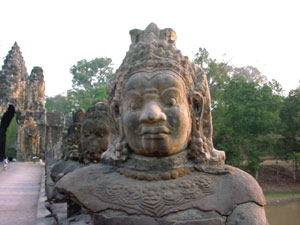 |
A line of stone warriors protect the south entrance to Angkor Thom. |
 |
The centerpiece of Angkor Thom is Bayon. Stone pillars of giant heads stand guard. Today, 117 out of the original 194 effigies remain. |
 |
A Buddha sculpture garbed in orange cloth meditates peacefully at the east corridor of Bayon Temple. |
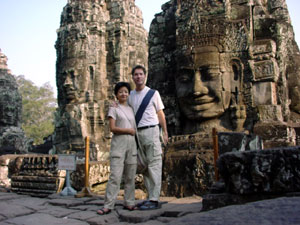 |
Masami and Wes stand atop the second level of Bayon to give a perspective of the size of each sculpted head. |
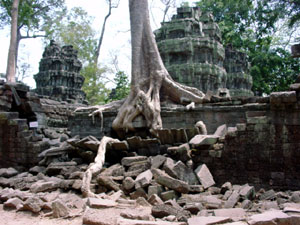 |
Tree roots at Ta Prohm appear to devour the temple ruins. Due to these giant living wonders, archeologists have left much of Ta Prohm exactly as it was discovered. |
 |
Masami walks through a section of Ta Prohm remains enshrouded in tree roots. |
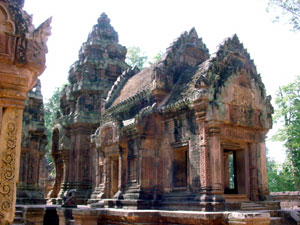 |
The most detailed carvings are found at Banteay Srei. Constructed of red, orange, and yellow sandstone, this temple is one of the prettiest. |
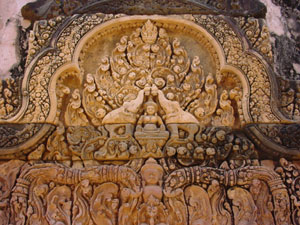 |
Happy elephants protect the center figurine top the main entrance to the center court of Banteay Srei.. |
 |
Female figures in traditional dress of the Angkor Empire decorate most of the exterior corners of Banteay Srei structures. |
Copyright © 2000-2002 Wes and Masami Heiser. All rights reserved.